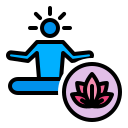Daytime Calm Builds Nighttime Rest
Set a phone reminder three times daily. Close your eyes, loosen your jaw, and exhale longer than you inhale. This tiny recalibration keeps stress from compounding, so bedtime begins from a gentler baseline.
Daytime Calm Builds Nighttime Rest
Before switching projects, take three guided breaths while imagining one door closing and another opening. This trains your brain to finish loops, reducing the cognitive clutter that often spills into pillows after dark.




